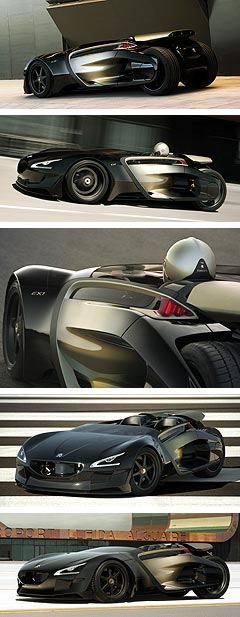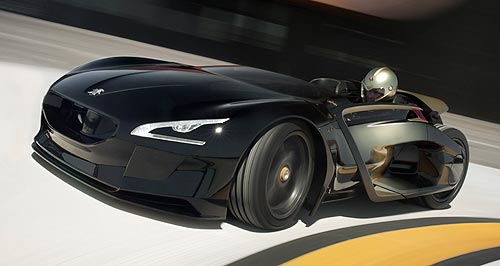Make / Model Search
Future models - Peugeot - EX1Paris show: Peugeot unveils trike-like EX1 conceptEjector seat: The EX1’s seats are incorporated into the doors to ease entry and egress. Ultra-light sports concept is propelled into the record books by electricity alone22 Sep 2010 THIS is Peugeot’s mysterious Paris show concept car, previously speculated to come with gullwing doors and an electric or HYbrid4 powertrain. GoAuto can now confirm the EX1 has an electric all-wheel drive system and unusual doors – but nobody could have guessed the rear-hinged doors would incorporate the seats. With a claimed ability to subject its driver to 1g during acceleration, Peugeot’s ultra-light, 250kW EX1 concept is no ordinary EV, although one look at the photos is enough to confirm that. Those seemingly meaningless teaser images suddenly make sense – because the car is so unconventional.  The seats, separated by a ‘backbone’ running the length of the cockpit, are integrated into the rear-hinged doors, offering a solution to the problem of gracefully entering and exiting low-slung sportscars by enabling driver and passenger to sit down before moving themselves into the car by closing the door. The seats, separated by a ‘backbone’ running the length of the cockpit, are integrated into the rear-hinged doors, offering a solution to the problem of gracefully entering and exiting low-slung sportscars by enabling driver and passenger to sit down before moving themselves into the car by closing the door.Once inside the “futuristic and sophisticated” cockpit of carbon-fibre, metal and embossed leather, both occupants, sitting at floor level with their legs outstretched, have their own instrumentation display. Rather than a steering wheel, the driver controls the EX1 using two handles, which Peugeot says provide a driving experience “similar to that of an aircraft pilot or video game”. Because the occupants are seated so low, they are protected by the carbon-fibre passenger cell, which includes a roll-over bar. However, with little in the way of wind protection for the driver (although the integrated wind deflector supposedly allows the car to be driven without a helmet), the all-wheel drive EX1 looks sure to provide the “intense driving sensations” Peugeot says it is capable of. The 750kg EX1 employs a 125kW/240Nm electric motor at each end to provide all-wheel drive and optimum weight distribution. Peugeot’s figures suggest that the high power-to-weight ratio and four-paw grip make it possible for the EX1 to complete the 0-100km/h sprint in 3.58 seconds and go on to reach its 260km/h maximum speed in just 6.6 seconds. More sedate driving should see the lithium-ion batteries lasting on average 450km between charges. With French explorer and film-maker Nicolas Vanier at the helm, the EX1 has broken, but not smashed, several acceleration world records for EVs weighing between 500 and 1000kg. The records had gone unchallenged since they were set in 1971 by Georg Von Opel, driving an Opel GT Electric. Peugeot claims that the record-breaking EX1 was not set up for maximum acceleration at the time and that like a go-kart, it depends almost entirely on its gearing to achieve different levels of performance. Later this year, Peugeot intends to reconfigure the EX1 to reach its full potential before taking it to China to break yet more records. With its exposed tyres and futuristic bodywork, the rear of the 0.9-metre high car is reminiscent of the most recent Batmobile, but uniquely, the back two wheels sit considerably closer together than those at the front. This is the third time the French company has produced a driveable sportscar concept with a narrow rear end. Whilst serving to demonstrate the company’s sporting and technological credentials, these vehicles have also been used to familiarise the public with the face of upcoming models. Peugeot’s 1996 Asphalte concept previewed the company’s new frontal styling direction that later debuted with the 206 and in 2005 the three-wheeled 20Cup concept exhibited an almost identical nosecone to that of the 207, which was announced a few months later. Likewise, the EX1 shares much of its front-end styling with the SR1 concept, so expect to see this face on the front of a French hatchback near you in the next couple of years. The 20Cup concept also previewed the now-familiar 1.6-litre turbocharged engine PSA Peugeot-Citroen co-developed with BMW. If history repeats itself, an all-electric drivetrain like that of the EX1, which is twice as powerful as its 20Cup predecessor, could end up under the bodywork of showroom models in the near future. Despite the pseudo-reverse trike layout, the French manufacturer, which also makes scooters and bicycles, says the EX1 achieves a high level of roadholding thanks to its drop-link double wishbone front suspension set-up and rear suspension comprising a single, centrally mounted shock absorber linked to the wheels via a single swingarm in a similar fashion to many motorcycles. In addition, the monocoque body, which incorporates all mounting points for the vehicle’s mechanical components, is made of a lightweight and rigid carbon/honeycomb composite. Like the EX1, next year’s 3008 HYbrid4 will use a similar principle of employing separate motors to power the front and rear wheels, aiding handling through more balanced weight distribution. In the case of the 3008, a diesel engine will be up front with an electric motor at the rear. Further down the track, Peugeot also plans to introduce vehicles powered by a plug-in version of its HYbrid4 technology with target tailpipe emissions of less than 50g/km of CO2 and fuel consumption as low as 2.0L/100km.  Read more13th of September 2010  Paris show: Peugeot goes for efficiency in new 508French car-maker spurns power for efficiency in new Peugeot 508 line-up for ParisAll future models Alfa Romeo Alfa Romeo Abarth Abarth Alpine Alpine Alpina Alpina Audi Audi Aston Martin Aston Martin BMW BMW Bentley Bentley Chery Chery Brabham Brabham Chrysler Chrysler Chevrolet Chevrolet Cupra Cupra Citroen Citroen DS DS Dodge Dodge Fiat Fiat Ferrari Ferrari Foton Foton Ford Ford Great Wall Great Wall FPV FPV Haval Haval GWM GWM Honda Honda Holden Holden Hummer Hummer HSV HSV Infiniti Infiniti Hyundai Hyundai Jaguar Jaguar Isuzu Isuzu Kia Kia Jeep Jeep Land Rover Land Rover Lamborghini Lamborghini Lexus Lexus LDV LDV Mahindra Mahindra Lotus Lotus Mazda Mazda Maserati Maserati Mercedes-AMG Mercedes-AMG McLaren McLaren MG MG Mercedes-Benz Mercedes-Benz Mitsubishi Mitsubishi Mini Mini Opel Opel Nissan Nissan Peugeot Peugeot Pagani Pagani Proton Proton Porsche Porsche Renault Renault Ram Ram Rover Rover Rolls-Royce Rolls-Royce Skoda Skoda Saab Saab SsangYong SsangYong Smart Smart Suzuki Suzuki Subaru Subaru Toyota Toyota Tesla Tesla Volvo VolvoMotor industry news |
Click to sharePeugeot modelsResearch Peugeot All future models Alfa Romeo Alfa Romeo Abarth Abarth Alpine Alpine Alpina Alpina Audi Audi Aston Martin Aston Martin BMW BMW Bentley Bentley Chery Chery Brabham Brabham Chrysler Chrysler Chevrolet Chevrolet Cupra Cupra Citroen Citroen DS DS Dodge Dodge Fiat Fiat Ferrari Ferrari Foton Foton Ford Ford Great Wall Great Wall FPV FPV Haval Haval GWM GWM Honda Honda Holden Holden Hummer Hummer HSV HSV Infiniti Infiniti Hyundai Hyundai Jaguar Jaguar Isuzu Isuzu Kia Kia Jeep Jeep Land Rover Land Rover Lamborghini Lamborghini Lexus Lexus LDV LDV Mahindra Mahindra Lotus Lotus Mazda Mazda Maserati Maserati Mercedes-AMG Mercedes-AMG McLaren McLaren MG MG Mercedes-Benz Mercedes-Benz Mitsubishi Mitsubishi Mini Mini Opel Opel Nissan Nissan Peugeot Peugeot Pagani Pagani Proton Proton Porsche Porsche Renault Renault Ram Ram Rover Rover Rolls-Royce Rolls-Royce Skoda Skoda Saab Saab SsangYong SsangYong Smart Smart Suzuki Suzuki Subaru Subaru Toyota Toyota Tesla Tesla Volvo VolvoMotor industry news |











Facebook Twitter Instagram